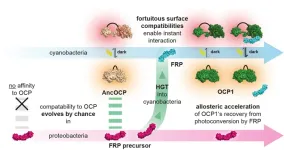(Press-News.org) Proteins are the key players for virtually all molecular processes within the cell. To fulfil their diverse functions, they have to interact with other proteins. Such protein-protein interactions are mediated by highly complementary surfaces, which typically involve many amino acids that are positioned precisely to produce a tight, specific fit between two proteins. However, comparatively little is known about how such interactions are created during evolution.
Classical evolutionary theory suggests that any new biological feature involving many components (like the amino acids that enable an interaction between proteins) evolves in a stepwise manner. According to this concept, each tiny functional improvement is driven by the power of natural selection because there is some benefit associated with the feature. However, whether protein-protein interactions also always follow this trajectory was not entirely known.
Using a highly interdisciplinary approach, an international team led by Max Planck researcher Georg Hochberg from the Terrestrial Microbiology in Marburg have now shed new light on this question. Their study provides definitive evidence that highly complementary and biologically relevant protein-protein interactions can evolve entirely by chance.
Proteins cooperate in a photoprotection system
The research team made their discovery in a biochemical system that microbes use to adapt to stressful light conditions. Cyanobacteria use sunlight to produce their own food through photosynthesis. Since much light damages the cell, cyanobacteria have evolved a mechanism known as photoprotection: if light intensities become dangerously high, a light intensity sensor named Orange Carotenoid Protein (OCP) changes its shape. In this activated form, OCP protects the cell by converting excess light energy into harmless heat. In order to return into its original state, some OCPs depend on a second protein: The Fluorescence Recovery Protein (FRP) binds to activated OCP1 and strongly accelerates its recovery.
‘Our question was: Is it possible that the surfaces that allow these two proteins to form a complex evolved entirely by accident, rather than through direct natural selection?’ says Georg Hochberg. ‘The difficulty is that the end result of both processes looks the same, so we usually cannot tell why the amino acids required for some interaction evolved – through natural selection for the interaction or by chance. To tell them apart, we would need a time machine to witness the exact moment in history these mutations occurred, ’Georg Hochberg explains.
Luckily, recent breakthroughs in molecular and computational biology has equipped Georg Hochberg and his team with a laboratory kind of time machine: ancestral sequence reconstruction. In addition, the light protection system of cyanobacteria, which is under study in the group of Thomas Friedrich from Technische Universität Berlin since many years, is ideal for studying the evolutionary encounter of two protein components. Early cyanobacteria acquired the FRP proteins from a proteobacterium by horizontal gene transfer. The latter had no photosynthetic capacity itself and did not possess the OCP protein.
To work out how the interaction between OCP1 and FRP evolved, graduate student Niklas Steube inferred the sequences of ancient OCPs and FRPs that existed billions of years ago in the past, and then resurrected these in the laboratory. After translation of the amino acid sequences into DNA he produced them using E. coli bacterial cells in order to be able to study their molecular properties.
A fortunate coincidence
The Berlin team then tested whether ancient molecules could form an interaction. This way the scientists could retrace how both protein partners got to know each other. ‘Surprisingly, the FRP from the proteobacteria already matched the ancestral OCP of the cyanobacteria, before gene transfer had even taken place. The mutual compatibility of FRP and OCP has thus evolved completely independently of each other in different species, says Thomas Friedrich. This allowed the team to prove that their ability to interact must have been a happy accident: selection could not plausibly have shaped the two proteins’ surfaces to enable an interaction if they had never met each other. This finally proved that such interactions can evolve entirely without direct selective pressure.
‘This may seem like an extraordinary coincidence,’ Niklas Steube says. ‘Imagine an alien spaceship landed on earth and we found that it contained plug-shaped objects that perfectly fit into human-made sockets. But despite the perceived improbability, such coincidences could be relatively common. But in fact, proteins often encounter a large number of new potential interaction partners when localisation or expression patterns change within the cell, or when new proteins enter the cell through horizontal gene transfer.’ Georg Hochberg adds, ‘Even if only a small fraction of such encounters ends up being productive, fortuitous compatibility may be the basis of a significant fraction of all interactions we see inside cells today. Thus, as in human partnerships, a good evolutionary match could be the result of a chance meeting of two already compatible partners.’
END
Blind dating in bacteria evolution
Reconstructed protein sequences in cyanobacteria reveal that protein interactions can evolve without direct selection pressure
2023-04-06
ELSE PRESS RELEASES FROM THIS DATE:
Costs of natural disasters set to spiral with continued rise in CO2 and global temperature, study shows
2023-04-06
BOSTON – Scientists have long predicted that global climate change could fuel an increase in the frequency and severity of natural disasters including hurricanes, heatwaves and cold snaps, droughts and floods and wildfires. In a paper published in the Journal of Climate Change and Health, members of the Beth Israel Deaconess Medical Center (BIDMC) Fellowship in Disaster Medicine estimated that climate change-related natural disasters have increased since 1980 and have already cost the United States more than $2 trillion in recovery costs. Their analysis also suggests that as atmospheric carbon dioxide levels and the global temperature continue to rise, ...
AERA announces 2023 award winners in education research
2023-04-06
Washington, April 6, 2023—The American Educational Research Association (AERA) has announced the winners of its 2023 awards for excellence in education research.
“We are honored to present this year’s awards to an excellent and deserving group of scholars,” said AERA Executive Director Felice J. Levine. “Their contributions to education research, across all career stages and fields, have made and continue to make a difference in the lives of students and educators.”
AERA will ...
Forest futures
2023-04-06
When you walk through a forest, you are surrounded by carbon. Every branch and every leaf, every inch of trunk and every tendril of unseen root contains carbon pulled from the atmosphere through photosynthesis. And as long as it stays stored away inside that forest, it’s not contributing to the rising concentrations of carbon dioxide that cause climate change. So it’s only natural that we might want to use forests’ carbon-storage superpower as a potential climate solution in addition to reducing human greenhouse gas emissions.
But climate change itself might compromise how permanently forests are able to store carbon and keep it out of the air, according to a new paper by ...
Cancer researchers identify protein with novel anti-tumoral activities
2023-04-06
AURORA, Colo. (April 6, 2023) – Understanding how cancer develops is critical for designing effective, personalized cancer therapies. Researchers have known for years that cancer begins with mutations in certain types of genes. One of these types of cancer genes are so-called “tumor suppressors.” When functioning normally, tumor suppressor genes can stop malignant cells from undergoing uncontrolled cell proliferation and initiate a process of cell elimination called apoptosis, a form of cell death. Mutations in tumor suppressor genes can cause these genes to lose their functionality, eventually contributing to the development of cancer.
In a recent ...
Long-forgotten equation provides new tool for converting carbon dioxide
2023-04-06
ITHACA, N.Y. – To manage atmospheric carbon dioxide and convert the gas into a useful product, Cornell University scientists have dusted off an archaic – now 120 years old – electrochemical equation.
The calculation – named the Cottrell equation for chemist Frederick Gardner Cottrell, who developed it in 1903 – can help today’s researchers understand the several reactions that carbon dioxide can take when electrochemistry is applied and pulsed on a lab bench.
The electrochemical reduction of carbon dioxide presents an opportunity to transform the gas from an environmental liability to a feedstock ...
Anti-smoking campaigns on Facebook that discuss the risks of second-hand smoking to pets receive the most user engagement
2023-04-06
Currently, 12.5% of U.S. adults smoke cigarettes. At the same time, more than one-third of U.S. adults seek health information online, making social media a potentially powerful platform for anti-tobacco campaigns. However, limited research has been done on effective social media strategies for anti-smoking campaigns.
An interprofessional Mason research team led by Associate Professors in the Department of Health Administration and Policy Hong Xue and Gilbert Gimm found that the most popular anti-tobacco campaigns on Facebook were informational and discussed the negative effects of smoking. ...
Kessler Foundation receives Craig H. Neilsen grant to improve return-to-work and employment outcomes for inpatients with spinal cord injury
2023-04-06
East Hanover, NJ – April 6, 2023 – Ada Chen, PhD, at Kessler Foundation was awarded a two-year grant for $187,000 from the Craig H. Neilsen Foundation to improve the return-to-work rate and employment outcomes for inpatients with spinal cord injury (SCI). Her study is titled “Employment after SCI: Stakeholder Perceptions and Experiences of Vocational Resource Facilitation.”
“The Vocational Resource Facilitation (VRF) pilot project – developed as an early intervention – has already shown promising outcomes in improving return-to-work rates,” said Dr. Chen. “Further investigation of VRF participant and stakeholder experiences and perceptions ...
Novel immunotherapy agent safe, shows promise against high-risk prostate cancers
2023-04-06
FOR IMMEDIATE RELEASE
A new drug, a monoclonal antibody known as enoblituzumab, is safe in men with aggressive prostate cancer and may induce clinical activity against cancer throughout the body, according to a phase 2 study led by investigators at the Johns Hopkins Kimmel Cancer Center and its Bloomberg~Kimmel Institute for Cancer Immunotherapy. If confirmed in additional studies, enoblituzumab could become the first promising antibody-based immunotherapy agent against prostate cancer.
In a clinical trial, 32 men with high-risk or very high-risk prostate cancers who were scheduled ...
Fiery response: “Siglec-14” receptors on human macrophages detect carbon nanotubes and provoke inflammation, finds study
2023-04-06
Carbon nanotubes (CNTs) have become a mainstay of the field of nanotechnology. Finding innovative applications across materials science, electronics, and medicine, CNTs have garnered a lot of attention from researchers in recent years. However, the International Chemical Secretariat (ChemSec) has moved to flag CNTs on the “Substitute It Now!” database of chemicals likely to be restricted for use. In fact, due to their persistence in nature and potential toxicity to humans, ChemSec has proposed that adequate assessments of CNTs' risk to human health are urgently needed.
Following their entry into the body, and much like asbestos, CNTs are targeted by the immune system and preferentially ...
Alternative glucose breakdown ensures the survival of cancer cells
2023-04-06
A key enzyme in sugar metabolism is inactivated particularly easily and efficiently by oxidative stress. Scientists at the German Cancer Research Center (Deutsches Krebsforschungszentrum, DKFZ) have now shown that with this oxidation, cells switch to an alternative sugar breakdown pathway and can thus escape oxidative stress. Cancer cells in particular benefit from this mechanism, which can also protect them from therapy-related damage.
One of the central enzymes in sugar breakdown, GAPDH (glyceraldehyde-3-phosphate dehydrogenase), ...
LAST 30 PRESS RELEASES:
Sleeping in on weekends may help boost teens’ mental health
Study: Teens use cellphones for an hour a day at school
After more than two years of war, Palestinian children are hungry, denied education and “like the living dead”
The untold story of life with Prader-Willi syndrome - according to the siblings who live it
How the parasite that ‘gave up sex’ found more hosts – and why its victory won’t last
When is it time to jump? The boiling frog problem of AI use in physics education
Twitter data reveals partisan divide in understanding why pollen season's getting worse
AI is quick but risky for updating old software
Revolutionizing biosecurity: new multi-omics framework to transform invasive species management
From ancient herb to modern medicine: new review unveils the multi-targeted healing potential of Borago officinalis
Building a global scientific community: Biological Diversity Journal announces dual recruitment of Editorial Board and Youth Editorial Board members
Microbes that break down antibiotics help protect ecosystems under drug pollution
Smart biochar that remembers pollutants offers a new way to clean water and recycle biomass
Rice genes matter more than domestication in shaping plant microbiomes
Ticking time bomb: Some farmers report as many as 70 tick encounters over a 6-month period
Turning garden and crop waste into plastics
Scientists discover ‘platypus galaxies’ in the early universe
Seeing thyroid cancer in a new light: when AI meets label-free imaging in the operating room
Neutrophil-to-lymphocyte ratio may aid risk stratification in depressive disorder
2026 Seismological Society of America Annual Meeting
AI-powered ECG analysis offers promising path for early detection of chronic obstructive pulmonary disease, says Mount Sinai researchers
GIMM uncovers flaws in lab-grown heart cells and paves the way for improved treatments
Cracking the evolutionary code of sleep
Medications could help the aging brain cope with surgery, memory impairment
Back pain linked to worse sleep years later in men over 65, according to study
CDC urges ‘shared decision-making’ on some childhood vaccines; many unclear about what that means
New research finds that an ‘equal treatment’ approach to economic opportunity advertising can backfire
Researchers create shape-shifting, self-navigating microparticles
Science army mobilizes to map US soil microbiome
Researchers develop new tools to turn grain crops into biosensors
[Press-News.org] Blind dating in bacteria evolutionReconstructed protein sequences in cyanobacteria reveal that protein interactions can evolve without direct selection pressure




